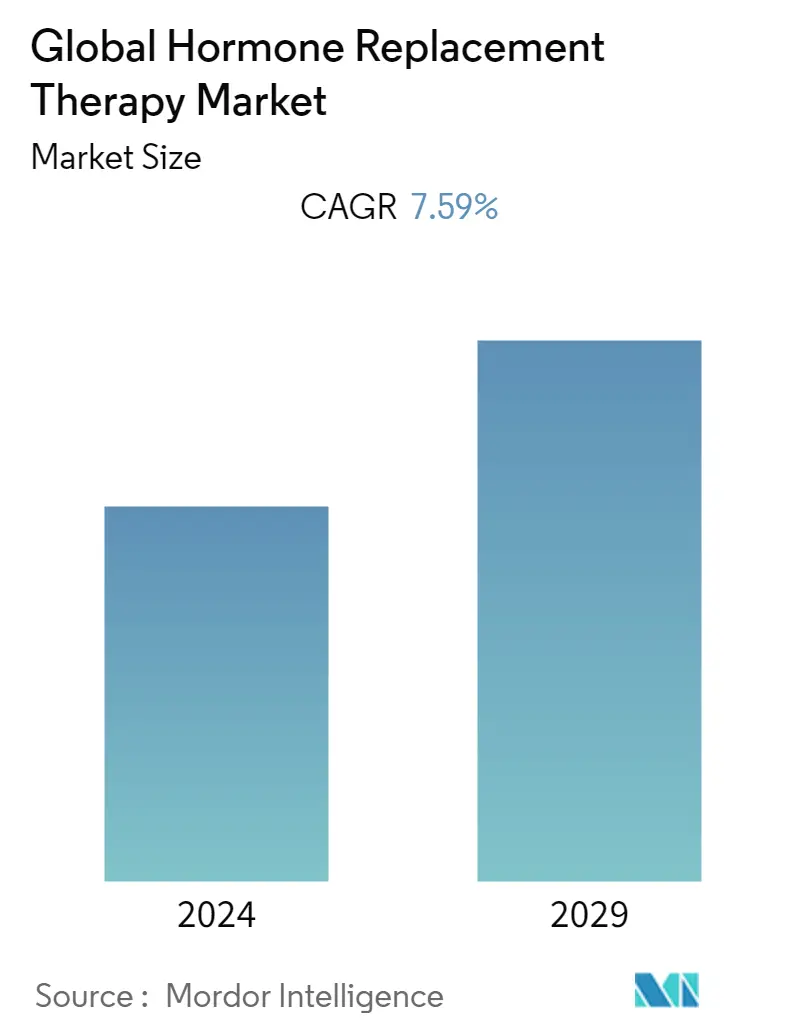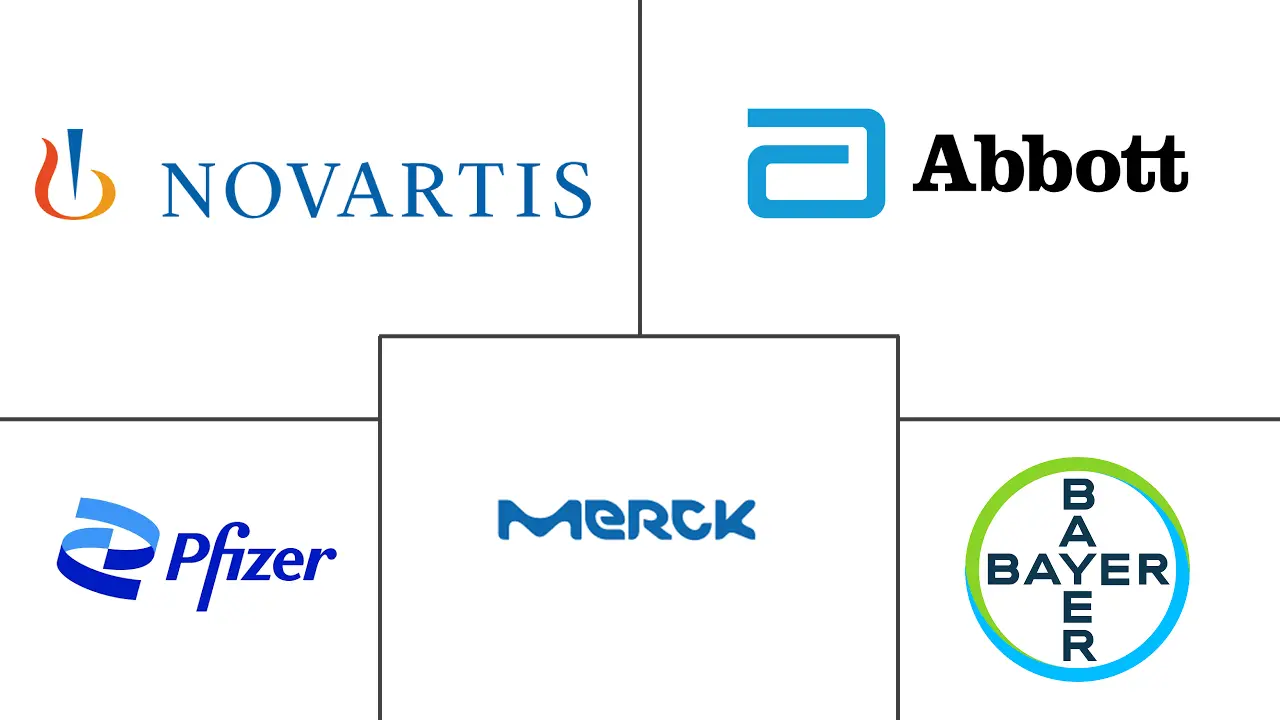Market Size of Global Hormone Replacement Therapy Industry

| Study Period | 2019 - 2029 |
| Base Year For Estimation | 2023 |
| CAGR | 7.59 % |
| Fastest Growing Market | Asia Pacific |
| Largest Market | North America |
| Market Concentration | High |
Major Players
*Disclaimer: Major Players sorted in no particular order |
Hormone Replacement Therapy (HRT) Market Analysis
The hormone replacement therapy market with a CAGR of 7.59% during the forecast period (2022-2027).
The COVID-19 pandemic is expected to have a significant impact on the home replacement therapy market. An increasing number of research studies have been carried out to find the application of hormone replacement therapy in COVID-19 infected patients. For instance, as per the research article titled 'Hormone Replacement Therapy May Reduce the Risk of COVID-19 Death in Post-Menopausal Women' published in February 2022, the risk of dying from COVID-19 may be lower in post-menopausal women who have greater estrogen levels because of hormone replacement therapy (HRT) than in those who have natural estrogen levels. Hence, due to the aforementioned factors, hormone replacement therapy is expected to play a promising role in developing novel therapeutics for the effective treatment of SARS-CoV2 virus infection, which may lead to the growth of the studied market during the pandemic.
Certain factors that are positively affecting the hormone replacement therapy (HRT) market growth are increasing awareness of post-menopausal issues among women, rise in drug development with novel delivery systems, and hormonal imbalance disorders with the rising geriatric population. According to World Population Prospects 2022 report-United States, the latest projections by the United Nations suggest that the global population could grow to around 8.5 billion in 2030, 9.7 billion in 2050, and 10.4 billion in 2100. With various kinds of hormonal changes, the female body predominantly gets affected by the natural process of aging, leading to abnormalities and diseases. Some of the common problems include weight gain, memory decline, fatigue, low libido, aging appearance, and muscle loss.
The most frequently reported consequence of age-related hormonal changes occurs in cases related to menopause. The global average onset age for menopause among women is approximately 50 years. In women, by the age of 50 years and above, the production levels of estrogen and progesterone decrease significantly. The decrease in production levels of estrogen and progesterone is compensated by the pituitary gland, with the increased production of follicle-stimulating hormone (FSH). This is physically manifested in women in the form of post-menopause symptoms, which include flush. These factors associated with age lead to the rising demand for HRT, thus driving the market studied.
Additionally, the growing R&D activities by the key players for the discovery of novel therapeutics to treat hormonal imbalances and rising product approvals are expected to aid in the growth of the studied market over the forecast period. However, the high cost of hormone replacement therapy and the risk of developing cancers with HRTs are anticipated to hamper the market growth globally.
Hormone Replacement Therapy (HRT) Industry Segmentation
As per the scope of the report, hormone replacement therapy (HRT) is a treatment technique for replacing and/or replenishing hormones in the human body, which are at inadequate levels than those required for the normal physiology of the human body. The most prominent application of HRT is in the treatment of symptom alleviation of menopause. The hormone replacement therapy market is segmented by therapy (estrogen hormone replacement, growth hormone replacement, thyroid hormone replacement, and testosterone replacement), route of administration (oral, parenteral, and other routes of administration), indication (menopause, hypothyroidism, growth hormone deficiency, and other indications), and geography (North America, Europe, Asia-Pacific, Middle-East and Africa, and South America). The market report also covers the estimated market sizes and trends for 17 different countries across major regions, globally. The report offers the value (USD million) for all the above segments.
| By Therapy | |
| Estrogen Hormone Replacement | |
| Growth Hormone Replacement | |
| Thyroid Hormone Replacement | |
| Testosterone Replacement |
| By Route of Administration | |
| Oral | |
| Parenteral | |
| Other Routes of Administration |
| By Indication | |
| Menopause | |
| Hypothyroidism | |
| Growth Hormone Deficiency | |
| Other Indications |
| Geography | ||||||||
| ||||||||
| ||||||||
| ||||||||
| ||||||||
|
Global Hormone Replacement Therapy Market Size Summary
The hormone replacement therapy (HRT) market is poised for significant growth, driven by increasing awareness of menopausal issues, advancements in drug development, and the rising prevalence of hormonal imbalances among the aging population. The market is experiencing a surge in demand due to the natural aging process, which leads to hormonal changes and associated health issues in women, particularly during menopause. The therapy plays a crucial role in alleviating symptoms such as mood swings, depression, and physical changes by maintaining estrogen levels. The COVID-19 pandemic has further highlighted the potential of HRT in therapeutic applications, particularly in reducing the risk of severe outcomes in post-menopausal women infected with the virus. This has spurred research and development activities, contributing to the market's expansion.
In North America, the HRT market is expected to witness robust growth, fueled by a substantial geriatric population and a high incidence of thyroid hormone imbalances. The region's market is characterized by a moderate level of competition, with major players like Abbott Laboratories, Bayer AG, Merck KGaA, Novartis AG, and Pfizer Inc. leading the charge. These companies are actively expanding their global product portfolios through strategic acquisitions and collaborations. The market is also benefiting from a trend of increasing product approvals, which is anticipated to drive adoption rates among women for both post-menopausal and menopause management. Despite challenges such as high treatment costs and potential cancer risks, the market's growth trajectory remains positive, supported by ongoing innovations and regulatory approvals.
Global Hormone Replacement Therapy Market Size - Table of Contents
-
1. MARKET DYNAMICS
-
1.1 Market Overview
-
1.2 Market Drivers
-
1.2.1 Increasing Awareness of Post-menopausal Issues among Women
-
1.2.2 Rise in Drug Development with Novel Delivery Systems
-
1.2.3 Hormonal Imbalance Disorders with Rising Geriatric Population
-
-
1.3 Market Restraints
-
1.3.1 High Cost of Hormone Replacement Therapy
-
1.3.2 Substantial Risk of Cancer Associated with Hormone Replacement Therapy
-
-
1.4 Porter's Five Forces Analysis
-
1.4.1 Threat of New Entrants
-
1.4.2 Bargaining Power of Buyers/Consumers
-
1.4.3 Bargaining Power of Suppliers
-
1.4.4 Threat of Substitute Products
-
1.4.5 Intensity of Competitive Rivalry
-
-
-
2. MARKET SEGMENTATION
-
2.1 By Therapy
-
2.1.1 Estrogen Hormone Replacement
-
2.1.2 Growth Hormone Replacement
-
2.1.3 Thyroid Hormone Replacement
-
2.1.4 Testosterone Replacement
-
-
2.2 By Route of Administration
-
2.2.1 Oral
-
2.2.2 Parenteral
-
2.2.3 Other Routes of Administration
-
-
2.3 By Indication
-
2.3.1 Menopause
-
2.3.2 Hypothyroidism
-
2.3.3 Growth Hormone Deficiency
-
2.3.4 Other Indications
-
-
2.4 Geography
-
2.4.1 North America
-
2.4.1.1 United States
-
2.4.1.2 Canada
-
2.4.1.3 Mexico
-
-
2.4.2 Europe
-
2.4.2.1 Germany
-
2.4.2.2 United Kingdom
-
2.4.2.3 France
-
2.4.2.4 Italy
-
2.4.2.5 Spain
-
2.4.2.6 Rest of Europe
-
-
2.4.3 Asia-Pacific
-
2.4.3.1 China
-
2.4.3.2 Japan
-
2.4.3.3 India
-
2.4.3.4 Australia
-
2.4.3.5 South Korea
-
2.4.3.6 Rest of Asia-Pacific
-
-
2.4.4 Middle-East and Africa
-
2.4.4.1 GCC
-
2.4.4.2 South Africa
-
2.4.4.3 Rest of Middle-East and Africa
-
-
2.4.5 South America
-
2.4.5.1 Brazil
-
2.4.5.2 Argentina
-
2.4.5.3 Rest of South America
-
-
-
Global Hormone Replacement Therapy Market Size FAQs
What is the current Global Hormone Replacement Therapy Market size?
The Global Hormone Replacement Therapy Market is projected to register a CAGR of 7.59% during the forecast period (2024-2029)
Who are the key players in Global Hormone Replacement Therapy Market?
Abbott Laboratories, Novartis AG, Pfizer Inc., Merck KGaA and Bayer AG are the major companies operating in the Global Hormone Replacement Therapy Market.

